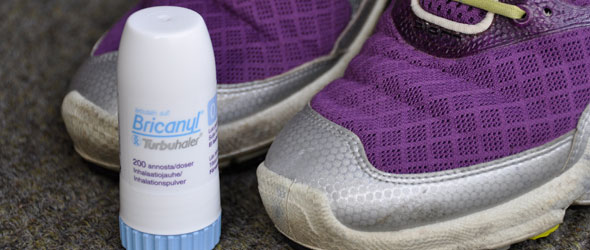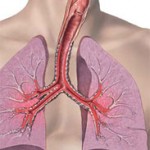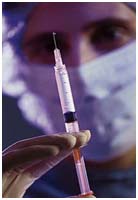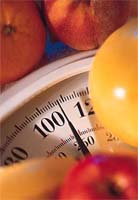Exercise-induced bronchial obstruction is also known as exercise-induced asthma (EIA).
This disease is one that occurs most in asthmatic persons. An exercise-induced asthmatic attack can be brought on by exercise in some individuals and can be provoked in others, on rare occasions, during moderate exercise.
The exact cause of EIA is not clear. Metabolic acidosis, postexertional hypocapnia, stimulation of tracheal irritant receptors, adrenergic abnormalities such as a defective catecholamine metabolism, and psychological factors have been suggested as possible causes.
Heat and water loss causes the greatest loss of airway activity. The eating of certain foods such as shrimp, celery, and peanuts can cause EIA. Sinusitis can also enhance the chance of an attack in chronic asthma sufferers.
Symptoms and signs:
The EIA athlete often shows an airway narrowing caused by the bronchial-wall thickening and excess mucus production. Those athletes who have a chronic inflammatory asthmatic condition (bronchiectasis) typically have an incessant dilation of the bronchi and or bronchioles. There is chest tightness, coughing, breathlessness, and wheezing.
The athlete with EIA may show signs of swelling of the face (angioedema), swelling of the palms and soles of the feet,nausea, hypertension, diarrhea, fatigue, itching, respiratory stridor (high-pitched noise on respiration), headaches, and redness of the skin. It may occur within 3 to 8 minutes of strenuous activity.
Control and treatment:
Swimming is the least bronchospasm-producing exercise, which may be a result of the moist, warm air environment. It is generally agreed that a regular exercise EIA bouts. There should be gradual warm-up and cool-down. The duration of exercise should build slowly to 30 to 40 minutes, four or five times per week. Exercise intensity and loading should gradually be increased. Many athletes with chronic or exercise-induced asthma use the bronchodilator inhaler. Exercise is best performed in warm, humid weather conditions. Wearing a mask or scarf may be of assistance in avoiding cold, dry air. Slow nasal breathing is recommended with the avoidance of exercising in areas where there is known to be a high level of air pollution or pollen counts.
The B2 agonist most commonly prescribed for EIA is albuterol, which is effective for around 2 hours. Salmeterol provides a prophylaxis for up to 12 hours. Albuterol should be taken 15 minutes before exercise commences and salmeterol 30 to 60 minutes before exercise. Cromolyn sodium should be inhaled 30 minutes prior to exercise. The metered-dose inhalers are preferred for administration. The prophylactic use of the bronchodilator 15 minutes before exercise, has been found to assist in the delaying of symptoms for 2 to 4 hours.
Asthmatic athletes who receive medication for their condition should always confer the legality of their medication before competition.
Listed below are 8 Upper Respiratory Infections
![]() sinusitis
sinusitis
![]() pharyngitis
pharyngitis
![]() influenza
influenza
![]() hay fever
hay fever
![]() infectious mononucleosis
infectious mononucleosis
![]() acute bronchitis
acute bronchitis
![]() bronchial asthma
bronchial asthma
![]() exercise induced bronchial obstruction (asthma)
exercise induced bronchial obstruction (asthma)



























[…] Exercise-induced asthma (EIA) – Upper Respiratory Infections is a post from: Sports Doctor section […]